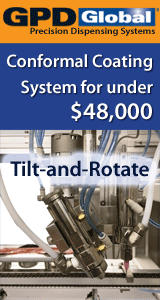| | | hello, | | | | | | has anyone tried dispensing solder paste in thru holes instead of waving or hand soldering. if so how did it work out for you. | | | thanks for the input | | | | | | wayne | | | | | | | | | | | We have tried this mainly on thru hole connectors (.035 pins, .1 spacing with .040 holes)and have had a great deal of success. the most important elements are the stencil aperature and the pin/hole size ratio. Our connectors are placed by hand so the operators needed to use a little caution not to push the connector in too hard or too fast and push the majority of the paste out of the hole and onto the bottom of the lead or on the floor even. | | Gentlemen | I have been planning to try this for a 96 pin right angle DIN connector in an upcoming product. I would appreciate your comments about pin/hole ratio, stencil aperture, stencil thickness, etc. thanks| | | I attended a seminar where Phil Zarrow was a speaker and he gave the following formulas to use as a guideline for paste in hole components:
Procedure for determining the solder stencil aperture size (print area) for through-hole components
Known information: Component lead size, Stencil thickness, and Inspection factor
Determine board hole size based on lead size: Round lead hole size = maximum diameter + .012" Square or rectangular lead hole size = maximum diagonal measurement + .010"
Formula:
H = Hole diameter D= Lead diameter T = Board thickness L = Width of lead in the X direction W = Width of lead in the Y direction p = 3.14 Hole Volume (HV) = (p)(H/2)(H/2)(T) Lead Volume (LV) = (p)(D/2)(D/2)(T) (for round leads) Lead Volume (LV) = (L)(W)(T) (For square or rectangular leads)
Required solder volume (SV) = HV - LV
Required Print Volume (PV) = (2)(SV) (50% shrinkage during reflow)
Required Print Area (PA) = (F)(PV)/stencil thickness
F = Inspection factor .7 = no fillet .9 = fillet on both sides .8 = fillet on primary side 1.0 = large fillet on both sides
I have been using this as a guideline for all the work I have done so far, I have fudged the aperature size up somewhat from the formula comes out to in most cases - just to get me in my own comfort zone as far as the fillet goes. We are generally doing .100" spaced connectors/headers and most have turned out with good solder joints and nice fillets. The aperature size I am using for these is .085" sq pads around each .035-.040" hole (6 mil stencil). I have also found that pin/hole ratio is most important - you'll see what I mean after you plug some different combinations into the formula - we had some dense connectors(100pin 4 row - .08 spacing) were the pin/hole ratio was so small (using vendor recommended hole size)that we couldn't put down enough paste to fill the hole and at the same time couldn't make the hole any smalller or insertion would become difficult getting the pins to line up. Good Luck!!
reply »
![]()
![]() hello,
has anyone tried dispensing solder paste in thru...
- Jun 24, 1999
by
Wayne S.
hello,
has anyone tried dispensing solder paste in thru...
- Jun 24, 1999
by
Wayne S.
![]()
![]()
![]() | hello,
|
| has anyone tried dispensing solder paste i...
- Jun 24, 1999
by
| hello,
|
| has anyone tried dispensing solder paste i...
- Jun 24, 1999
by
![]()
![]() Wayne, Earl,
I wish there was some way we could toss ou...
- Jun 25, 1999
by
Scott Davies
Wayne, Earl,
I wish there was some way we could toss ou...
- Jun 25, 1999
by
Scott Davies
![]()
![]()
![]() | hello,
|
| has anyone tried dispensing solder paste i...
- Jun 25, 1999
by
| hello,
|
| has anyone tried dispensing solder paste i...
- Jun 25, 1999
by
![]()
![]() | | hello,
| |
| | has anyone tried dispensing solder p...
- Jun 25, 1999
by
| | hello,
| |
| | has anyone tried dispensing solder p...
- Jun 25, 1999
by
![]()
![]() | | | hello,
| | |
| | | has anyone tried dispensing so...
- Jun 25, 1999
by
Jeff Strumpf
| | | hello,
| | |
| | | has anyone tried dispensing so...
- Jun 25, 1999
by
Jeff Strumpf
![]()
![]()
![]() | | | hello,
| | |
| | | has anyone tried dispensing so...
- Jun 28, 1999
by
| | | hello,
| | |
| | | has anyone tried dispensing so...
- Jun 28, 1999
by






